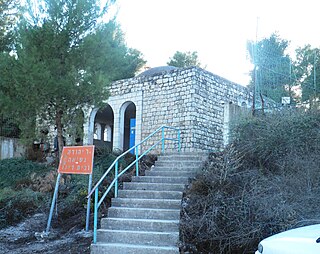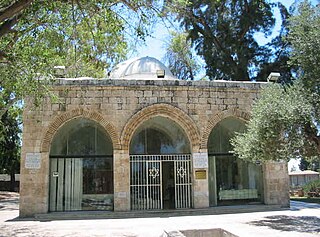Related Research Articles
Rabbi Abbahu was a Jew and Talmudist of the Talmudic Academies in Syria Palaestina from about 279-320 and is counted a member of the third generation of Amoraim. He is sometimes cited as Rabbi Abbahu of Kisrin (Caesarea).

Judah ha-Nasi or Judah I, was a second-century rabbi and chief redactor and editor of the Mishnah. He lived from approximately 135 to 217 CE. He was a key leader of the Jewish community during the Roman occupation of Judea.
Amoraim refers to Jewish scholars of the period from about 200 to 500 CE, who "said" or "told over" the teachings of the Oral Torah. They were primarily located in Babylonia and the Land of Israel. Their legal discussions and debates were eventually codified in the Gemara. The Amoraim followed the Tannaim in the sequence of ancient Jewish scholars. The Tannaim were direct transmitters of uncodified oral tradition; the Amoraim expounded upon and clarified the oral law after its initial codification.

The Sanhedrin were assemblies of either twenty-three or seventy-one elders, who were appointed to sit as a tribunal in every city in the ancient Land of Israel.
Tannaim were the rabbinic sages whose views are recorded in the Mishnah, from approximately 10–220 CE. The period of the Tannaim, also referred to as the Mishnaic period, lasted about 210 years. It came after the period of the Zugot ("pairs"), and was immediately followed by the period of the Amoraim ("interpreters").
Johanan bar Nappaha was a leading rabbi in the early era of the Talmud. He belonged to the second generation of amoraim.

Judah II or Nesi'ah I was a Jewish sage who lived in Tiberias in the Land of Israel, in the middle of the third century CE.
Judah III, Yudan Nesiah, was a prominent Jewish sage, who held the office of Nasi of the ancient Jewish Sanhedrin between about 290 and 320 CE.
Simeon ben Shetach, or Shimon ben Shetach or Shatach, circa 140-60 BCE, was a Pharisee scholar and Nasi of the Sanhedrin during the reigns of Alexander Jannæus and his successor, Queen Salome Alexandra, who was Simeon's sister. He was therefore closely connected with the court, enjoying, at least initially, the favor of Alexander.
Shim‘on ben Lakish, better known by his nickname Reish Lakish, was an amora who lived in the Roman province of Syria Palaestina in the third century. He was reputedly born in Bosra, east of the Jordan River, around 200 CE, but lived most of his life in Sepphoris. Nothing is known of his ancestry except his father's name.

Rabban Gamaliel II was a rabbi from the second generation of tannaim. He was the first person to lead the Sanhedrin as nasi after the fall of the Second Temple in 70 CE.
Rabbi Zeira, known before his semicha as Rav Zeira and known in the Jerusalem Talmud as Rabbi Ze'era, was a Jewish Talmudist, of the third generation of amoraim, who lived in the Land of Israel.
Gamaliel III was a 3rd century rabbi.
Jose ben Halafta or Yose ben Halafta was a tanna of the fourth generation. He is the fifth-most-frequently mentioned sage in the Mishnah. Of the many Rabbi Yose's in the Talmud, Yose Ben Halafta is the one who is simply referred to as Rabbi Yose.

Levi ben Sisi or Levi bar Sisi was a Jewish scholar, one of the semi-tannaim of the late 2nd century and early 3rd century.
Rabbi Ammi, Aimi, Immi is the name of several Jewish Talmudists, known as amoraim, who lived in the Land of Israel and Babylonia. In the Babylonian Talmud the first form only is used; in the Jerusalem Talmud all three forms appear, Immi predominating, and sometimes R. Ammi is contracted into "Rabmi" or "Rabbammi".
Samuel ben Nahman or Samuel [bar] Nahmani was a rabbi of the Talmud, known as an amora, who lived in the Land of Israel from the beginning of the 3rd century until the beginning of the 4th century.
Judah IV held the office of Nasi of the ancient Jewish Sanhedrin between 385 and 400 CE, following Gamaliel V. He was the son of Gamaliel V, and grandson of Hillel II. He was succeeded by Gamaliel VI, the last occupant of the office.
The Talmudic Academies in Syria Palaestina were yeshivot that served as centers for Jewish scholarship and the development of Jewish law in Syria Palaestina between the destruction of the Second Temple circa 70 CE and the deposition of Raban Gamliel VI circa 425 CE. The academies had a great and lasting impact on the development of world Jewry, including the creation of the Jerusalem Talmud. The region designated as the Land of Israel / Eretz Yisrael in Jewish sources was during the Talmudic period also officially known as Syria Palaestina and Palaestina Prima / Palaestina Secunda.
References
| Preceded by Judah II | Nasi 270–290 | Succeeded by Judah III |